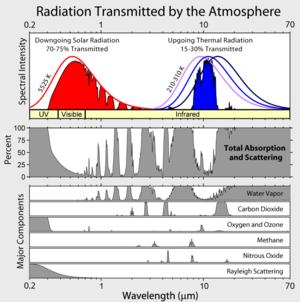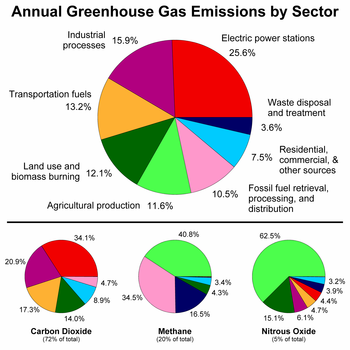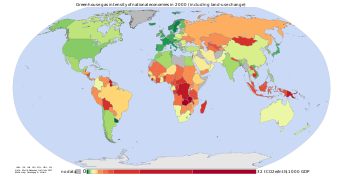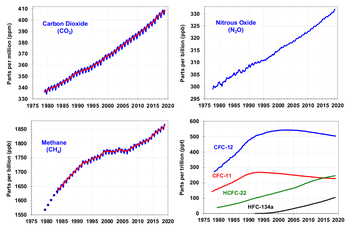Greenhouse gas: Difference between revisions
| [pending revision] | [pending revision] |
→The role of atmospheric water: as Kim pointed out on the Talk page, clouds (discussed only in this section) are not water vapor |
m Reverted to revision 201009727 by KimDabelsteinPetersen; rv WP:POINT. Clouds are mentioned in a small sentence - all else is water vapor. WV is a GHG - Clouds are not.. using TW |
||
| Line 68: | Line 68: | ||
[[CFCs]], although greenhouse gases, are regulated by the [[Montreal Protocol]], which was motivated by CFCs' contribution to [[ozone depletion]] rather than by their contribution to global warming. Note that ozone depletion has only a minor role in greenhouse warming though the two processes often are confused in the popular media. |
[[CFCs]], although greenhouse gases, are regulated by the [[Montreal Protocol]], which was motivated by CFCs' contribution to [[ozone depletion]] rather than by their contribution to global warming. Note that ozone depletion has only a minor role in greenhouse warming though the two processes often are confused in the popular media. |
||
== The role of |
== The role of water vapor == |
||
[[Image:BAMS climate assess boulder water vapor 2002.png|thumb|350px|Increasing water vapor at Boulder, Colorado.]] |
[[Image:BAMS climate assess boulder water vapor 2002.png|thumb|350px|Increasing water vapor at Boulder, Colorado.]] |
||
Revision as of 14:53, 26 March 2008

Greenhouse gases are components of the atmosphere that contribute to the greenhouse effect. Without the greenhouse effect the Earth would be uninhabitable;[1] in its absence, the mean temperature of the earth would be about −19 °C (−2 °F, 254 K) rather than the present mean temperature of about 15 °C (59 °F, 288 K)[2]. Greenhouse gases include, in order of relative abundance: water vapour, carbon dioxide, methane, nitrous oxide, ozone and CFCs. Greenhouse gases come from natural sources and human activity; present CO2 levels are 380 ppmv, approximately 100 ppmv higher than they were in pre-industrial times.
The "greenhouse effect"

When sunlight reaches the surface of the Earth, some of it is absorbed and warms the surface. Because the Earth's surface is much cooler than the sun, it radiates energy at much longer wavelengths than the sun does, peaking in the infrared at about 10µm. The atmosphere absorbs these longer wavelengths more effectively than it does the shorter wavelengths from the sun. The absorption of this longwave radiant energy warms the atmosphere; the atmosphere also is warmed by transfer of sensible and latent heat from the surface. Greenhouse gases also emit longwave radiation both upward to space and downward to the surface. The downward part of this longwave radiation emitted by the atmosphere is the "greenhouse effect." The term is a misnomer, as this process is not the mechanism that warms greenhouses.
The major greenhouse gases are water vapor, which causes about 36–70% of the greenhouse effect on Earth (not including clouds); carbon dioxide, which causes 9–26%; methane, which causes 4–9%, and ozone, which causes 3–7%. It is not possible to state that a certain gas causes a certain percentage of the greenhouse effect, because the influences of the various gases are not additive. (The higher ends of the ranges quoted are for the gas alone; the lower ends, for the gas counting overlaps.)[3][4] Other greenhouse gases include, but are not limited to, nitrous oxide, sulfur hexafluoride, hydrofluorocarbons, perfluorocarbons and chlorofluorocarbons (see IPCC list of greenhouse gases).
The major atmospheric constituents (nitrogen, N2 and oxygen, O2) are not greenhouse gases. This is because homonuclear diatomic molecules such as N2 and O2 neither absorb nor emit infrared radiation, as there is no net change in the dipole moment of these molecules when they vibrate. Molecular vibrations occur at energies that are of the same magnitude as the energy of the photons on infrared light. Heteronuclear diatomics such as CO or HCl absorb IR; however, these molecules are short-lived in the atmosphere owing to their reactivity and solubility. As a consequence they do not contribute significantly to the greenhouse effect.
Late 19th century scientists experimentally discovered that N2 and O2 did not absorb infrared radiation (called, at that time, "dark radiation") and that CO2 and many other gases did absorb such radiation. It was recognized in the early 20th century that the known major greenhouse gases in the atmosphere caused the earth's temperature to be higher than it would have been without the greenhouse gases.
Natural and anthropogenic

Most greenhouse gases have both natural and anthropogenic sources. During the pre-industrial holocene, levels of the gases were roughly constant. Since the industrial revolution, levels of some gases have increased due to human actions.
| Gas | Preindustrial Level | Current Level | Increase since 1750 | Radiative forcing (Wm2) |
|---|---|---|---|---|
| Carbon dioxide | 280 ppm | 384ppm | 87 ppm | 1.46 |
| Methane | 700 ppb | 1,745 ppb | 1,045 ppb | 0.48 |
| Nitrous oxide | 270 ppb | 314 ppb | 44 ppb | 0.15 |
| CFC-12 | 0 | 533 ppt | 533 ppt | 0.17 |
Ice cores provide evidence for variation over the past 800,000 years. Both CO2 and CH4 vary between glacial and interglacial phases, and correlate strongly with temperature. Before the ice core record, direct measurements do not exist. Various proxies and modelling suggests large variations; 500 Myr ago CO2 levels were likely 10 times higher than now [5].
Anthropogenic greenhouse gases


Since about 1750 human activity has increased concentration of carbon dioxide and of some other important greenhouse gases.[6] Natural sources of carbon dioxide are more than 20 times greater than sources due to human activity,[7] but over periods longer than a few years natural sources are closely balanced by natural sinks. As a result of this balance, the atmospheric concentration of carbon dioxide remained between 260 and 280 parts per million for the 10,000 years between the end of the last glacial maximum and the start of the industrial era.[8]
Some of the main sources of greenhouse gases due to human activity include:
- burning of fossil fuels and deforestation leading to higher carbon dioxide concentrations;
- livestock and paddy rice farming, land use and wetland changes, pipeline losses, and covered vented landfill emissions leading to higher methane atmospheric concentrations. Many of the newer style fully vented septic systems that enhance and target the fermentation process also are major sources of atmospheric methane;
- use of chlorofluorocarbons (CFCs) in refrigeration systems, and use of CFCs and halons in fire suppression systems and manufacturing processes.
- agricultural activities, including the use of fertilizers, that lead to higher nitrous oxide concentrations.
The seven sources of CO2 from fossil fuel combustion are (with percentage contributions for 2000–2004)[9]:
- Solid fuels (e.g. coal): 35%
- Liquid fuels (e.g. gasoline): 36%
- Gaseous fuels (e.g. natural gas): 20%
- Flaring gas industrially and at wells: <1%
- Cement production: 3%
- Non-fuel hydrocarbons: <1%
- The "international bunkers" of shipping and air transport not included in national inventories: 4%
The U.S. EPA ranks the major greenhouse gas contributing end-user sectors in the following order: industrial, transportation, residential, commercial and agricultural[10]. Major sources of an individual's GHG include home heating and cooling, electricity consumption, and transportation. Corresponding conservation measures are improving home building insulation, compact fluorescent lamps and choosing high miles per gallon vehicles.
Carbon dioxide, methane, nitrous oxide and three groups of fluorinated gases (sulfur hexafluoride, HFCs, and PFCs) are the major greenhouse gases and the subject of the Kyoto Protocol, which entered into force in 2005.[11]
CFCs, although greenhouse gases, are regulated by the Montreal Protocol, which was motivated by CFCs' contribution to ozone depletion rather than by their contribution to global warming. Note that ozone depletion has only a minor role in greenhouse warming though the two processes often are confused in the popular media.
The role of water vapor

Water vapor is a naturally occurring greenhouse gas and accounts for the largest percentage of the greenhouse effect, between 36% and 66% [12]. Water vapor concentrations fluctuate regionally, but human activity does not directly affect water vapor concentrations except at local scales (for example, near irrigated fields).
Current state-of-the-art climate models include fully interactive clouds[13]. They show that an increase in atmospheric temperature caused by the greenhouse effect due to anthropogenic gases will in turn lead to an increase in the water vapor content of the troposphere, with approximately constant relative humidity. The increased water vapor in turn leads to an increase in the greenhouse effect and thus a further increase in temperature; the increase in temperature leads to still further increase in atmospheric water vapor; and the feedback cycle continues until equilibrium is reached. Thus water vapor acts as a positive feedback to the forcing provided by human-released greenhouse gases such as CO2.[14]
Greenhouse gas emissions
Measurements from Antarctic ice cores show that just before industrial emissions started, atmospheric CO2 levels were about 280 parts per million by volume (ppm; the units µL/L are occasionally used and are identical to parts per million by volume). From the same ice cores it appears that CO2 concentrations stayed between 260 and 280 ppm during the preceding 10,000 years. Studies using evidence from stomata of fossilized leaves suggest greater variability, with CO2 levels above 300 ppm during the period 7,000–10,000 years ago,[15] though others have argued that these findings more likely reflect calibration/contamination problems rather than actual CO2 variability.[16][17]
Since the beginning of the Industrial Revolution, the concentrations of many of the greenhouse gases have increased. The concentration of CO2 has increased by about 100 ppm (i.e., from 280 ppm to 380 ppm). The first 50 ppm increase took place in about 200 years, from the start of the Industrial Revolution to around 1973; the next 50 ppm increase took place in about 33 years, from 1973 to 2006. Template:PDFlink. Many observations are available on line in a variety of Atmospheric Chemistry Observational Databases. The greenhouse gases with the largest radiative forcing are:
| Gas | Current (1998) Amount by volume | Increase over pre-industrial (1750) | Percentage increase | Radiative forcing (W/m²) |
|---|---|---|---|---|
| Carbon dioxide | ||||
| Methane | ||||
| Nitrous oxide |

| Gas | Current (1998) Amount by volume |
Radiative forcing (W/m²) |
|---|---|---|
| CFC-11 | ||
| CFC-12 | ||
| CFC-113 | ||
| Carbon tetrachloride | ||
| HCFC-22 |
(Source: IPCC radiative forcing report 1994 updated (to 1998) by IPCC TAR table 6.1 [2][3]).
Recent rates of change and emission

The sharp acceleration in CO2 emissions since 2000 of >3% y−1 (>2 ppm y−1) from 1.1% y−1 during the 90's is attributable to the lapse of formerly declining trends in carbon intensity of both developing and developed nations. Although over 3/4 of cumulative anthropogenic CO2 is still attributable to the developed world, China was responsible for most of global growth in emissions during this period. Localised plummeting emissions associated with the collapse of the Soviet Union have been followed by slow emissions growth in this region due to more efficient energy use, made necessary by the increasing proportion of it that is exported.[9] In comparison, methane has not increased appreciably, and N2O by 0.25% y−1[4].
Asia
Atmospheric levels of the main greenhouse gas have set another new peak in a sign of the industrial rise of Asian economies led by China. [18] Over the 2000-2010 interval China is expected to increase its carbon emissions by 600 MT, largely because of the rapid construction of old-fashioned power plants in poorer internal provinces.[19]
United States
The United States emitted 16.3% more GHG in 2005 than it did in 1990.[20] According to a preliminary estimate by the Netherlands Environmental Assessment Agency, the largest national producer of CO2 emissions since 2006 has been China with an estimated annual production of about 6200 megatonnes. It is followed by the United States with about 5,800 megatonnes. Relative to 2005, China's fossil CO2 emissions increased in 2006 by 8.7%, while in the USA, comparable CO2 emissions decreased in 2006 by 1.4%. The agency notes that its estimates do not include some CO2 sources of uncertain magnitude[21]. Although these tonnages are small compared to the CO2 in the Earth's atmosphere, they are significantly larger than pre-industrial levels.
Removal from the atmosphere and global warming potential

Aside from water vapor, which has a residence time of days, most greenhouse gases take many years to leave the atmosphere. Although it is not easy to know with precision how long it takes greenhouse gases to leave the atmosphere, there are estimates for the principal greenhouse gases.
Greenhouse gases can be removed from the atmosphere by various processes:
- as a consequence of a physical change (condensation and precipitation remove water vapor from the atmosphere).
- as a consequence of chemical reactions within the atmosphere. This is the case for methane. It is oxidized by reaction with naturally occurring hydroxyl radical, OH· and degraded to CO
2 and water vapor at the end of a chain of reactions (the contribution of the CO
2 from the oxidation of methane is not included in the methane Global warming potential). This also includes solution and solid phase chemistry occurring in atmospheric aerosols. - as a consequence of a physical interchange at the interface between the atmosphere and the other compartments of the planet. An example is the mixing of atmospheric gases into the oceans at the boundary layer.
- as a consequence of a chemical change at the interface between the atmosphere and the other compartments of the planet. This is the case for CO
2, which is reduced by photosynthesis of plants, and which, after dissolving in the oceans, reacts to form carbonic acid and bicarbonate and carbonate ions (see ocean acidification). - as a consequence of a photochemical change. Halocarbons are dissociated by UV light releasing Cl· and F· as free radicals in the stratosphere with harmful effects on ozone (halocarbons are generally too stable to disappear by chemical reaction in the atmosphere).
- as a consequence of dissociative ionization caused by high energy cosmic rays or lightning discharges, which break molecular bonds. For example, lightning forms N anions from N2 which then react with O2 to form NO2.

2
Atmospheric lifetime
The parameter atmospheric lifetime describes how long it takes to restore the system to equilibrium following an increase in the concentration of a greenhouse gas in the atmosphere. Individual molecules may be exchanged with sinks such as the soil, the oceans, vegetation and other biological systems, reducing the excess to background concentrations, and the average time taken to achieve this is the mean lifetime. The atmospheric lifetime of CO
2 is often incorrectly stated to be only a few years because that is the average time for any CO
2 molecule to stay in the atmosphere before being removed by mixing into the ocean, uptake by photosynthesis, or other processes. However, this ignores the balancing fluxes of CO
2 into the atmosphere from the other reservoirs. It is the net concentration changes of the various greenhouse gases by all sources and sinks that determines atmospheric lifetime, not just the removal processes.
Examples of the atmospheric lifetime and GWP for several greenhouse gases include:
- CO2 has a variable atmospheric lifetime, and cannot be specified precisely[22]. Recent work indicates that recovery from a large input of atmospheric CO
2 from burning fossil fuels will result in an effective lifetime of tens of thousands of years.[23][24] Carbon dioxide is defined to have a GWP of 1 over all time periods. - Methane has an atmospheric lifetime of 12 ± 3 years and a GWP of 62 over 20 years, 23 over 100 years and 7 over 500 years. The decrease in GWP associated with longer times is associated with the fact that the methane is degraded to water and CO2 by chemical reactions in the atmosphere.
- Nitrous oxide has an atmospheric lifetime of 120 years and a GWP of 296 over 100 years.
- CFC-12 has an atmospheric lifetime of 100 years and a GWP of 10600 over 100 years.
- HCFC-22 has an atmospheric lifetime of 12.1 years and a GWP of 1700 over 100 years.
- Tetrafluoromethane has an atmospheric lifetime of 50,000 years and a GWP of 5700 over 100 years.
- Sulfur hexafluoride has an atmospheric lifetime of 3,200 years and a GWP of 22000 over 100 years.
Airborne fraction
Airborne fraction (AF) is the proportion of a GHG emission
(usually CO
2) remaining in the atmosphere after a specified time. Canadell (2007)[25] define the annual AF as the ratio of the atmospheric CO
2 increase in a given year to that year’s total emissions, and calculate that of the average 9.1 PgC y-1 of total anthropogenic emissions from 2000 to 2006, the AF was 0.45. For CO
2 the AF over the last 50 years (1956-2006) has been increasing at 0.25±0.21 %/year.[25]
Global warming potential
The global warming potential (GWP) depends on both the efficiency of the molecule as a greenhouse gas and its atmospheric lifetime. GWP is measured relative to the same mass of CO
2 and evaluated for a specific timescale. Thus, if a molecule has a high GWP on a short time scale (say 20 years) but has only a short lifetime, it will have a large GWP on a 20 year scale but a small one on a 100 year scale. Conversely, if a molecule has a longer atmospheric lifetime than CO2 its GWP will increase with time.
Related effects

Carbon monoxide has an indirect radiative effect by elevating concentrations of methane and tropospheric ozone through scavenging of atmospheric constituents (e.g., the hydroxyl radical, OH) that would otherwise destroy them. Carbon monoxide is created when carbon-containing fuels are burned incompletely. Through natural processes in the atmosphere, it is eventually oxidized to carbon dioxide. Carbon monoxide has an atmospheric lifetime of only a few months[26] and as a consequence is spatially more variable than longer-lived gases.
Another potentially important indirect effect comes from methane, which in addition to its direct radiative impact also contributes to ozone formation. Shindell et al (2005)[27] argue that the contribution to climate change from methane is at least double previous estimates as a result of this effect.[28]
See also
References
- ^ http://www.sciencemag.org/cgi/content/full/302/5651/1719
- ^ http://ipcc-wg1.ucar.edu/wg1/Report/AR4WG1_Print_Ch01.pdf
- ^ Kiehl, J. T. (1997). "Earth's Annual Global Mean Energy Budget" (PDF). Bulletin of the American Meteorological Society. 78 (2): 197–208. Retrieved 2006-05-01.
{{cite journal}}: Unknown parameter|coauthors=ignored (|author=suggested) (help); Unknown parameter|month=ignored (help) - ^ "Water vapour: feedback or forcing?". RealClimate. 6 Apr 2005. Retrieved 2006-05-01.
- ^ Image:Phanerozoic Carbon Dioxide.png
- ^ "Climate Change 2001: Working Group I: The Scientific Basis: figure 6-6". Retrieved 2006-05-01.
- ^ The present carbon cycle - Climate Change
- ^ http://www.ipcc.ch/pdf/assessment-report/ar4/wg1/ar4-wg1-chapter7.pdf Climate Change 2007 The Physical Science Basis. Chapter 7: Couplings Between Changes in the Climate System and Biogeochemistry
- ^ a b Raupach, M.R. et al. (2007) "Global and regional drivers of accelerating CO2 emissions." Proc. Nat. Acad. Sci. 104(24): 10288–10293.
- ^ U.S. Greenhouse Gas Inventory - U.S. Greenhouse Gas Inventory Reports | Climate Change - Greenhouse Gas Emissions | U.S. EPA
- ^ Lerner & K. Lee Lerner, Brenda Wilmoth (2006). "Environmental issues : essential primary sources."". Thomson Gale. Retrieved 2006-09-11.
- ^ realclimate.org. Water vapour: feedback or forcing?.
- ^ BBC News. Models 'key to climate forecasts'.
- ^
Held, Isaac M.; Soden, Brian J. (2006), "Robust Responses of the Hydrological Cycle to Global Warming" (PDF), Journal of Climate, 19 (21): 5686–5699, doi:10.1175/JCLI3990, retrieved 2007-07-11
{{citation}}: Cite has empty unknown parameter:|1=(help) - ^ Friederike Wagner, Bent Aaby and Henk Visscher (2002). "Rapid atmospheric CO2 changes associated with the 8,200-years-B.P. cooling event". PNAS. 99 (19): 12011–12014. doi:10.1073/pnas.182420699.
- ^ Andreas Indermühle, Bernhard Stauffer, Thomas F. Stocker (1999). "Early Holocene Atmospheric CO2 Concentrations". Science. 286 (5446): 1815. doi:10.1126/science.286.5446.1815a.
{{cite journal}}: CS1 maint: multiple names: authors list (link) "Early Holocene Atmospheric CO2 Concentrations". Science. Retrieved May 26.{{cite web}}: Check date values in:|accessdate=(help); Unknown parameter|accessyear=ignored (|access-date=suggested) (help) - ^ H.J. Smith, M Wahlen and D. Mastroianni (1997). "The CO2 concentration of air trapped in GISP2 ice from the Last Glacial Maximum-Holocene transition". Geophysical Research Letters. 24 (1): 1–4.
- ^ Planet Ark : Greenhouse Gases at New Peak in Sign of Asia Growth
- ^ [http://ucsdnews.ucsd.edu/newsrel/international/03-08ChinasCarbonDioxideEmissions.asp "UC Analysis Shows Alarming Increase in Expected Growth of China's Carbon Dioxide Emissions" accessed 2008-03-11
- ^ Emissions inventory from the EPA, cited in Science News, vol. 171, p. 318
- ^ ""China now no. 1 in CO2 emissions; USA in second position"". 2007. Retrieved 2007-06-21.
- ^ Solomon, Susan; Qin, Dahe; Manning, Martin; Marquis, Melinda; Averyt, Kristen; Tignor, Melinda M.B.; Miller, Jr., Henry LeRoy; Chen, Zhenlin, eds. (2007), "Frequently Asked Question 7.1 "Are the Increases in Atmospheric Carbon Dioxide and Other Greenhouse Gases During the Industrial Era Caused by Human Activities?"" (PDF), IPCC, 2007: Climate Change 2007: The Physical Science Basis. Contribution of Working Group I to the Fourth Assessment Report of the Intergovernmental Panel on Climate Change, Cambridge, United Kingdom and New York, NY, USA: Cambridge Press, ISBN 978-0521-88009-1, retrieved 2007-07-24
{{citation}}: Check date values in:|access-date=(help) - ^ Archer, David (2005), "Fate of fossil fuel CO
2 in geologic time" (PDF), Journal of Geophysical Research, 110 (C9): C09S05.1-C09S05.6, doi:10.1029/2004JC002625, retrieved 2007-07-27 - ^ Caldeira, Ken; Wickett, Michael E. (2005), "Ocean model predictions of chemistry changes from carbon dioxide emissions to the atmosphere and ocean" (PDF), Journal of Geophysical Research, 110 (C9): C09S04.1-C09S04.12, doi:10.1029/2004JC002671, retrieved 2007-07-27
- ^ a b Canadell, J.G. (2007). "Contributions to accelerating atmospheric CO
2 growth from economic activity, carbon intensity, and efficiency of natural sinks" (PDF). Proceedings of the National Academy of Sciences: 0702737104v1. Retrieved 2008-03-15.{{cite journal}}: Unknown parameter|coauthors=ignored (|author=suggested) (help) - ^ Template:PDFlink
- ^ Shindell, Drew T.; Faluvegi, Greg; Bell, Nadine; Schmidt, Gavin A. "An emissions-based view of climate forcing by methane and tropospheric ozone", Geophysical Research Letters, Vol. 32, No. 4 [1]
- ^ Methane's Impacts on Climate Change May Be Twice Previous Estimates
External links
- Greenhouse-gas reduction technologies for coal-fired power generation.
- The NOAA Annual Greenhouse Gas Index (AGGI).
- Greenhouse Gases Sources, Levels, Study results — University of Michigan; eia.gov findings
Carbon dioxide emissions
- International Energy Annual: Reserves
- International Energy Annual 2003: Carbon Dioxide Emissions
- International Energy Annual 2003: Notes and Sources for Table H.1co2 (Metric tons of carbon dioxide can be converted to metric tons of carbon equivalent by multiplying by 12/44)
- DOE — EIA — Alternatives to Traditional Transportation Fuels 1994 — Volume 2, Greenhouse Gas Emissions (includes "Greenhouse Gas Spectral Overlaps and Their Significance")
- NOAA Paleoclimatology Program — Vostok Ice Core
- NOAA CMDL CCGG — Interactive Atmospheric Data Visualization NOAA CO2 data
- Carbon Dioxide Information Analysis Centre FAQ Includes links to Carbon Dioxide statistics
- Little Green Data Book 2007, World Bank. Lists C02 statistics by country, including per capita and by country income class.
- Flight Carbon Emission Calculator
Methane emissions
- BBC News — Thawing Siberian bogs are releasing more methane
- METHANE-EATING BUG HOLDS PROMISE FOR CUTTING GREENHOUSE GAS. Media Release, GNS Science, New Zealand
Policy and advocacy
- Australian Greenhouse Gas Initiative
- Global Green Plan, a not-for profit organisation based in Melbourne, Australia, developing school curriculum to teach youth how to reduce emissions
- Carbon Dioxide is Good for the Environment 2001 paper by the National Center for Public Policy Research
- Environmental Effects of Increased Atmospheric Carbon Dioxide paper by the Oregon Institute of Science and Medicine
- EU page about reducing CO2 emissions from light-duty vehicles : the EU's aim is to reach — by 2010 at the latest — an average CO2 emission figure of 120 g/km for all new passenger cars marketed in the Union.
